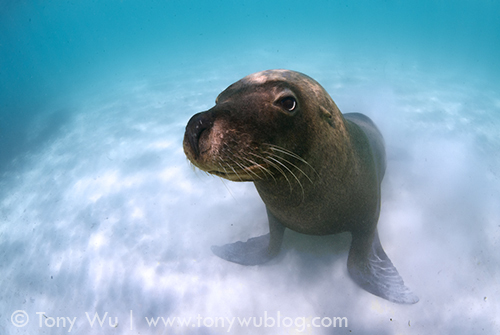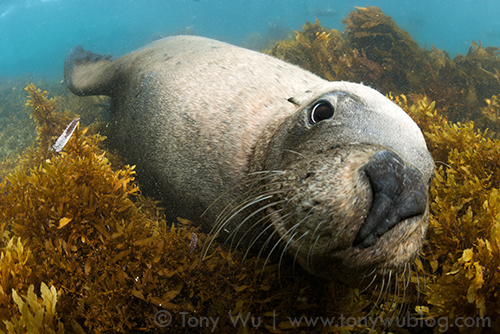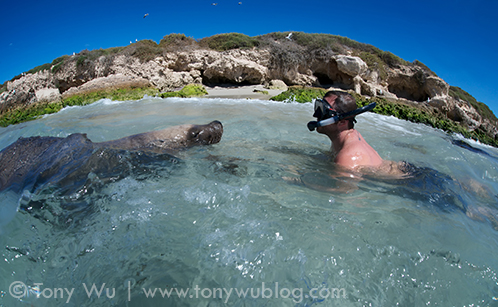My time with the wonderful Australian sea lions (Neophoca cinerea) is over (much too quickly, as always), and I'm on the road again.

Endangered Australian sea lion (Neophoca cinerea)
perched in shallow water at Carnac Island in Western Australia
I treasure any time that I can spend with pinnipeds, but I'm particularly attached to this colony.
You see…Australian sea lions are endemic to Western Australia and South Australia, and they're listed as endangered on the IUCN Red List.
Estimates I've read put the total number of these animals in the thousands, maybe up to 12,000 individuals or so, though I'm not sure whether there's been any methodical census undertaken in recent years.
The specific sea lion colony I've visited several times is located at Carnac Island in Western Australia, which is the primary haul-out area for Australian sea lions in this vicinity.
Within this context, the Carnac colony seems especially vulnerable…for a couple of reasons.
First, the community comprises only males. Yup. No females at all.
Now…the individuals that frequent Carnac probably aren't celibate. They presumably travel a few hundred kilometres up the coast at the appropriate time (i.e., mating season) to strut their stuff in front of pretty female sea lions.
As far as I've been able to gather, this is the only instance of a pinniped colony that is a boys-only club. No one knows why this colony is the way it is. It just is.
But with no females in the area, it's clear that this colony cannot be self-sustaining. There needs to be inflow from other sea lion colonies.

Endangered Australian sea lion (Neophoca cinerea) relaxing on a bed of seaweed
The second reason is people. No surprise there I suppose.
Some years ago, when I first visited this colony, I was shocked to see rampant abuse of these animals and their home by boaters…people who were drunk, loud, and well…stupid and obnoxious.
Among other things, I saw people kicking sand at sea lions, throwing objects at them, dragging large kites across and over them, etc.
(I wrote at length about what I observed, so if you're interested, please click here to read more. It's pretty appalling.)
Anyway, it seems that despite the passage of over six years since my first visit, things haven't changed much.
CALM, the agency with oversight over Carnac Island and the sea lions, has since been rebranded as Department of Environment and Conservation (DEC), but protection for the sea lions doesn't seem to have improved in any substantial manner.
Boaters still descend on the island during weekends, and the sea lions still have to contend with lots of boats, loud music, and intoxicated people traipsing over the beach.
I understand that DEC has stopped people from driving their boats onto the beach (yes, it was actually ok to drive right into sleeping sea lions before), so they do deserve credit for that.
Still…it's odd.
The same people who seem perfectly happy with inebriated boaters harassing the sea lions are quite quick to scold sober tourists who visit Carnac to observe and interact with the sea lions on their own terms.
Representatives of DEC approached us on three occassions to tell us, among other things, that: "It is the closed season for sea lions." Puzzled, I asked the natural question: "When is the open season?"
After a momentary pause to consider the unexpected query, the guy driving the Marine Parks boat said: "Swimming with sea lions is indefinitely closed."
Well, I'm not a native speaker of English, but to me, "indefinitely closed" seems more like a ban, not a closed "season".
The thing is, I saw a number of advertisements in (government-supported) tourist booklets and brochures promoting in-water encounters with sea lions. That doesn't exactly jive with a ban, does it?
So I'm not really sure what the situation is.
Perhaps no one is.
Anyway, this confusing behaviour isn't new; it's been the same since I first visited in 2007.
Which I guess is my point: So long as the relevant authorities choose to place priority on delivering mixed messages to tourists rather than on addressing real harassment, the endangered sea lions are going to have a rough time.
As it happened, I saw fewer sea lions this time than during any prior visit; where it was normal before to see over a dozen lying on the beach, we never saw more than five on this visit (usually far fewer).
There could, of course, be any number of reasons behind this; it's difficult to pinpoint any single cause.
But I can't help but think that ongoing harassment by boatloads of irresponsible people, made possible by the complicity of DEC, must be a contributing factor.

Interspecies communication at its best,
with the sea lion deciding when, where and how to interact